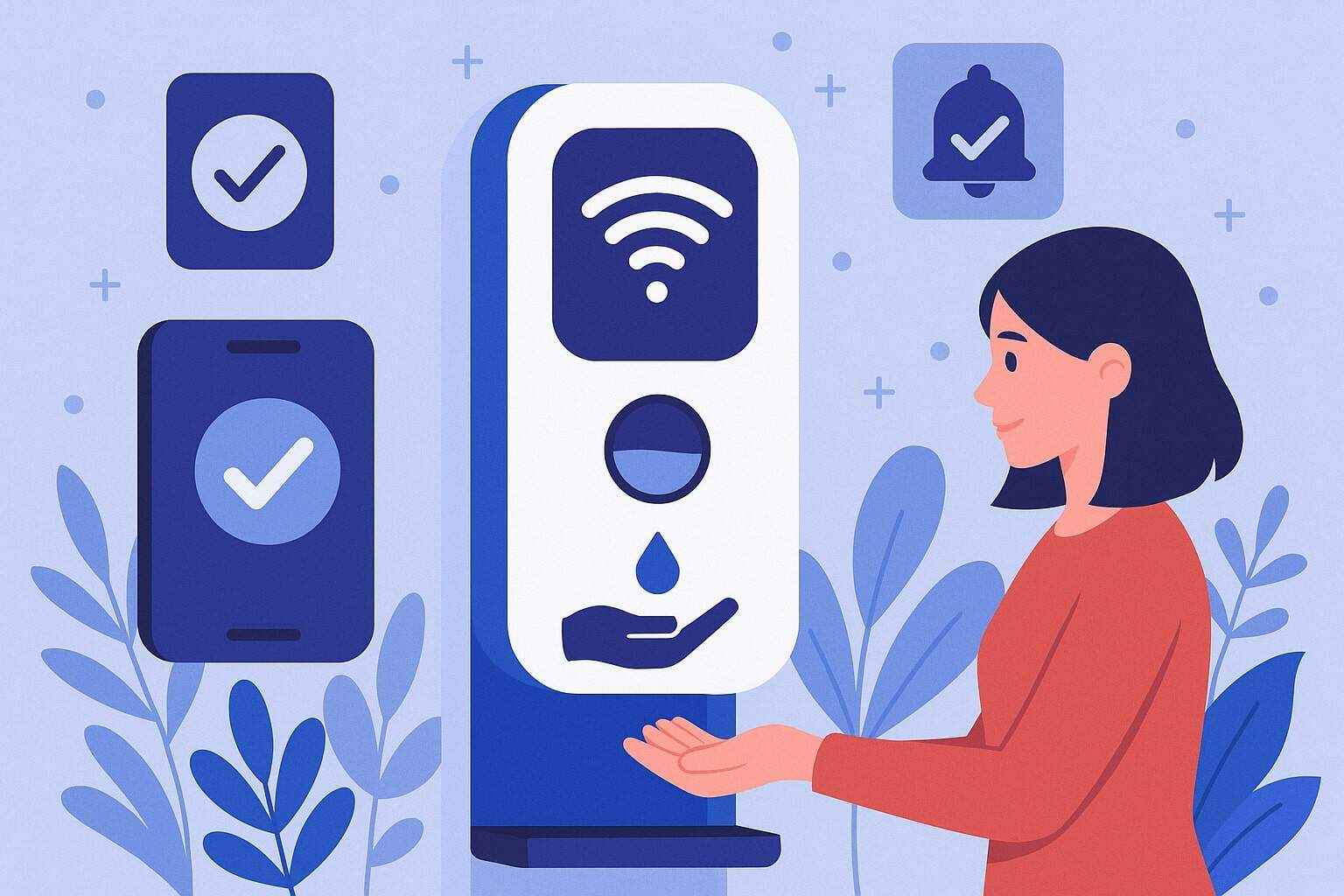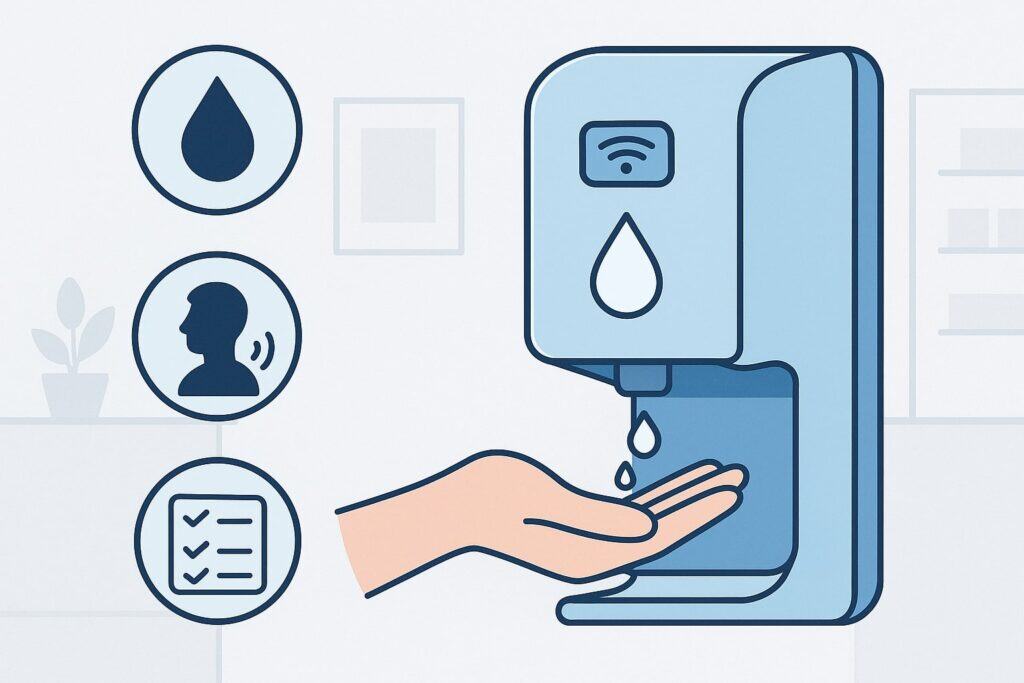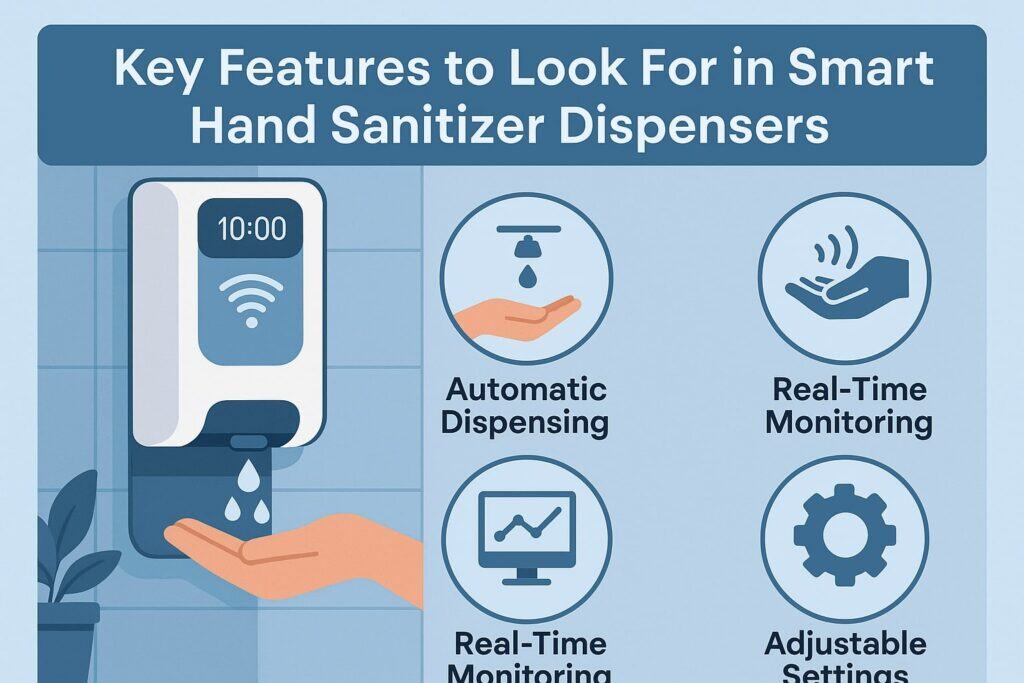
By myhandsanitizershop October 16, 2025
Smart hand sanitizer dispensers are reshaping hygiene in offices, schools, retail, transportation hubs, and healthcare. These connected, touch-free devices automate dosing, track consumption, surface refill alerts, and help organizations prove that hygiene stations are where they should be—and used.
For U.S. businesses focused on safety, compliance, and guest confidence, smart hand sanitizer dispensers provide a measurable way to raise hand hygiene standards while reducing waste and labor.
Throughout this guide, we’ll break down how smart hand sanitizer dispensers work, the features that matter, where to place them, the regulatory guardrails you should know in the U.S., and how to evaluate ROI.
We also include FAQs and a practical checklist so you can deploy smart hand sanitizer dispensers with confidence and keep your facilities clean, compliant, and welcoming.
What Smart Hand Sanitizer Dispensers Are and How They Work

At their core, smart hand sanitizer dispensers are sensor-activated units that detect hands and deliver a precise dose of sanitizer gel, foam, or liquid without contact.
“Smart” means they also include electronics that monitor events—like dispenses, battery status, and reservoir levels—and then store or transmit that data via Bluetooth, Wi-Fi, or cellular.
Unlike basic wall pumps, smart hand sanitizer dispensers can alert staff before they run empty, auto-throttle doses to reduce overuse, and verify uptime across a portfolio of locations. For multi-site operators, that means fewer walk-bys, fewer complaints, and consistently available hygiene.
Most smart hand sanitizer dispensers rely on infrared or time-of-flight sensors to trigger dosing. A control board drives a peristaltic pump or solenoid valve calibrated to the sanitizer’s viscosity.
The better systems support multiple cartridges and viscosity profiles so you can switch between foaming and gel formulations without swapping hardware. Power comes from long-life batteries or hardwired adapters; some models enable energy-saving sleep modes or adaptive dosing to stretch battery life during off-hours.
Because hand hygiene is ultimately about reducing pathogen transmission, reputable suppliers pair smart hand sanitizer dispensers with alcohol-based formulations meeting U.S. guidance: use an alcohol-based sanitizer with at least 60% alcohol when soap and water aren’t available, and rub until dry.
The Centers for Disease Control and Prevention (CDC) emphasizes soap and water as the gold standard when available, with sanitizers as the next best option.
Benefits for U.S. Businesses and Public Spaces

Smart hand sanitizer dispensers deliver a triple win: better user experience, better compliance, and better cost control. Touchless activation and consistent dosing improve trust and reduce mess around high-traffic stations like elevators, cafeterias, and lobbies.
For operations teams, real-time alerts reduce the chance of “empty dispenser” moments that frustrate guests and staff. Data from smart hand sanitizer dispensers can demonstrate that dispensers are maintained, placed, and functioning—evidence that matters for internal audits and third-party certifications.
From a health perspective, widely available sanitizer helps interrupt germ transmission between handwashing opportunities. CDC guidance says that alcohol-based rubs with at least 60% alcohol help when soap and water aren’t accessible, especially after touching shared surfaces or before eating on the go.
In clinical settings, hand hygiene protects both patients and personnel; while consumer workplaces aren’t hospitals, the principle of accessible, visible, and functioning dispensers still applies to reduce spread. Smart hand sanitizer dispensers make the “accessible and functioning” piece measurable.
Budget-wise, smart hand sanitizer dispensers often pay for themselves through controlled dosing, proactive refilling, and fewer service rounds. With accurate usage counts, you can forecast inventory and right-size purchasing.
You’ll also reduce shrinkage from over-dispensing and spills. For multi-location brands, these savings multiply—while the analytics help central teams spot underused or badly placed units and optimize layouts.
Key Features to Look For in Smart Hand Sanitizer Dispensers

Touchless sensing, precision dosing, and user-centric design
The best smart hand sanitizer dispensers combine reliable, touchless activation with adjustable dosing. Look for infrared or time-of-flight sensors that minimize false triggers in sunlight or near glass.
Precision dosing (for example, 0.6 mL, 1.0 mL, or 1.2 mL) keeps usage predictable and supports CDC’s recommendation to apply enough sanitizer to cover all surfaces of the hands and rub until dry.
Since hand sanitizer can vary in viscosity, ensure your smart hand sanitizer dispensers support foam and gel cartridges and auto-adjust pump speed or pulse duration for consistent output. Well-designed spouts reduce drips; drip trays and splash guards keep floors safe.
User-centric details matter. A subtle LED near the nozzle can reassure users that a dispense happened. Quiet motors reduce perceived noise in libraries, clinics, and conference rooms.
For accessibility, confirm that activation is effortless with one hand and that the unit’s “operable parts” sit within ADA reach ranges when mounted (we cover exact guidance later).
Smart hand sanitizer dispensers that support “hands under, dose delivered, light confirms” create a quick, intuitive loop that encourages frequent use without slowing foot traffic. For maintenance teams, tool-less cartridge swaps and keyed locks prevent tampering while keeping service time low.
Connectivity, dashboards, and actionable analytics
Connectivity transforms dispensers from passive hardware into a managed hygiene network. Common options include local Bluetooth for drive-by uploads, Wi-Fi for on-premises dashboards, and LTE for distributed locations with no corporate network access.
Dashboards should show online status, battery level, fill level (estimated or via sensor), dispense counts, and time-since-last-service. Alerts—empty, low battery, offline—should be configurable to avoid alert fatigue.
Beyond basics, analytics from smart hand sanitizer dispensers help optimize placement by mapping usage peaks to entrances, cafeterias, meeting rooms, and restrooms. Over time you can A/B test positions, dose amounts, and signage.
If you manage healthcare or high-risk environments, note that the Joint Commission and NFPA codes allow alcohol-based hand rub (ABHR) dispensers in corridors and patient rooms when specific fire-safety requirements are met—dashboards that inventory locations and volumes per smoke compartment help you stay within limits.
Even in non-clinical facilities, those fire-safety conventions are useful guardrails when placing many alcohol-based dispensers in egress paths.
Power, refills, formulations, and total lifecycle cost
Smart hand sanitizer dispensers are only “smart” if they stay powered and filled. Battery packs should last months under typical traffic; look for sleep modes and adaptive transmission intervals to extend life.
If you have fixed stations at security lines or entrances, consider low-voltage adapters to eliminate battery swaps altogether. Cartridge flexibility is critical—choose dispensers with OEM or open system options so you’re not locked into one vendor.
For U.S. workplaces, stick with alcohol-based formulations aligned with FDA and CDC guidance (e.g., ethyl alcohol or isopropyl alcohol products that meet the consumer antiseptic rub framework).
Remember, consumers should use products with at least 60% alcohol, and labels should clearly disclose active ingredients and percentages. Avoid “DIY” fills that could be ineffective or damage pump components.
U.S. Compliance and Safety Basics for Smart Hand Sanitizer Dispensers
A smart dispenser is equipment; the sanitizer inside is regulated as an over-the-counter (OTC) drug when marketed for consumer use in the U.S. The FDA’s consumer antiseptic rub final rule and related guidance address which active ingredients are eligible for evaluation under the OTC framework.
Ethyl alcohol and isopropyl alcohol remain key activities considered in that process, and manufacturers must comply with applicable drug-labeling and quality requirements.
If you’re procuring private-label sanitizer for your smart hand sanitizer dispensers, verify that the product and manufacturer meet OTC requirements and Good Manufacturing Practices (GMP).
From a public-health standpoint, the CDC reiterates that handwashing with soap and water is best whenever possible; when it’s not, use a hand sanitizer with at least 60% alcohol and rub until dry.
Your training, signage, and internal policies should align with this message so employees and visitors know when to sanitize versus when to wash. In clinical environments, hand hygiene protects patients and staff; accessible, functioning dispensers are a cornerstone of that practice.
Finally, consider fire-safety rules. Alcohol-based hand rubs are flammable, and codes such as NFPA 101 (referenced by the Joint Commission) set limits on dispenser size, spacing, and aggregate volumes per smoke compartment, plus requirements to avoid installation over ignition sources.
Even if you operate non-healthcare buildings, adopting these conservative placement principles reduces risk and simplifies conversations with landlords, insurers, and AHJs (authorities having jurisdiction).
Placement and Accessibility Best Practices
Where you put smart hand sanitizer dispensers determines how often they get used. Start by mapping traffic flows: building entrances, elevator banks, reception counters, break rooms, cafeterias, restrooms exits, conference rooms, and near shared equipment.
Visibility and “just-in-time” placement matter—users are more likely to use a dispenser they see as they enter a dining area or exit a restroom. Use analytics from your smart hand sanitizer dispensers to validate these assumptions and relocate low-performing units.
Accessibility is a must. Under the ADA, “operable parts” must be placed within reach ranges on accessible routes and in accessible rooms and spaces. Practically, wall-mounted smart hand sanitizer dispensers should be installed so a person using a wheelchair can approach and activate them.
The U.S. Access Board’s guidance on operable parts provides the framework; many facilities aim for controls at or below typical maximum reach heights to serve the broadest set of users.
In child-focused spaces, consider advisory reach ranges tailored to children’s dimensions, and ensure the unit is operable with one hand and minimal strength. Choose models that dispense with a simple hand-present gesture and avoid tight clearances that impede approach.
If you’re placing many alcohol-based dispensers in corridors, review fire-safety guidance that governs spacing, volume limits, and placement away from ignition sources.
The Joint Commission’s interpretation referencing NFPA 101 is a good starting point for healthcare-like environments; using those same constraints in commercial buildings will keep you on the safe side.
Add drip trays where floors are sensitive, and position signage at eye level to prompt use. Smart hand sanitizer dispensers with location-aware dashboards help you keep a clean inventory of units, mounting heights, and any local constraints.
Security and Data Privacy for Connected Dispensers
Because smart hand sanitizer dispensers are connected devices, they should fit your organization’s IoT security posture.
NIST has published baseline guidance for IoT cybersecurity that translates well to hygiene equipment: identify device capabilities and risks; require secure update mechanisms; enforce authentication for admin interfaces; and manage device inventory. For federal environments or contractors, NIST SP 800-213 and 800-213A outline device cybersecurity considerations and profiles that can be adapted to enterprise procurement checklists.
Even when dispensers only send telemetry like battery level and dispenses, they still touch your network—treat them with the same due diligence you apply to smart locks or cameras.
Best practice includes network segmentation for IoT, disabling unused services, rotating credentials, and ensuring data in transit is encrypted. Ask vendors how they handle firmware signing, vulnerability disclosure, and patch distribution.
Evaluate whether the system needs personally identifiable information (PII); most smart hand sanitizer dispensers do not, so avoid features that capture video or track individuals. If you deploy mobile apps for maintenance staff, apply MDM controls and enforce MFA.
Finally, document your asset inventory—MAC addresses, models, firmware versions—so you can respond quickly to security advisories or recalls.
Buying Checklist and ROI Model
Before you buy smart hand sanitizer dispensers, align on goals: reduce empty-dispenser incidents, cut sanitizer spend, prove compliance, or all of the above. Then evaluate:
- Form factor & durability: Wall, stand, or recessed. Metal housings for public transit; antimicrobial plastics for clinics.
- Dispense performance: Adjustable doses, foam/gel support, drip control, and reliable sensors that handle sunlight and glass.
- Power options: Battery life under realistic traffic; AC adapters for always-on stations.
- Refill flexibility: OEM vs. open cartridges; clear labeling of active ingredients and alcohol percentage (aim for ≥60% alcohol); tamper-resistant locks.
- Connectivity & software: Wi-Fi/LTE options, secure onboarding, dashboards with alerts, open APIs, and exportable reports.
- Security: Compliance with NIST-inspired controls, signed firmware, and documented patch process.
- Compliance support: Mounting templates that respect ADA reach; documentation to help with NFPA/Joint Commission-style placement in healthcare.
- Total cost: Hardware, cartridges, mounts, stands, batteries/power, software licenses, and field service.
For ROI, compare your current “manual” program (labor rounds, emergency refills, waste from over-dispensing) to a smart program (fewer rounds, proactive refills, controlled dosing).
Add soft benefits: reduced complaints, improved guest ratings, and audit readiness. Smart hand sanitizer dispensers pay back fastest in high-traffic spaces with many units and limited staff time—airports, stadiums, big offices, and campuses.
Maintenance and Troubleshooting
Even the smartest hand hygiene program fails if dispensers sit empty or offline. Assign ownership—janitorial, facilities, or EHS—and codify SLAs: refill when below X%, replace batteries at Y%, inspect placement quarterly.
Use your dashboard to batch work orders and avoid redundant walk-bys. When a unit goes offline, check power first, then network credentials. Many smart hand sanitizer dispensers support local Bluetooth sync as a backup when Wi-Fi is down.
For dosing issues, confirm you’re using the right cartridge type and that viscosity matches the pump calibration. Excess dripping? Reduce dose size, add a drip tray, and inspect for foam/gel mismatch.
If users report “no dispense,” test the sensor path for dust or reflective glare; adjust angle or add a small shield if the unit sits opposite bright windows. In winter, cold sanitizer thickens—choose climate-tolerant formulations or relocate wall units away from drafty entrances.
Finally, keep records: unit ID, location, first-install date, firmware version, and service history. Smart hand sanitizer dispensers make that easy—export logs monthly and store them with your safety documentation.
Future Trends: Where Smart Hand Sanitizer Dispensers Are Headed
Smart hand sanitizer dispensers are part of a broader wave of “facility health IoT.” Expect more accurate fill sensors (ultrasonic or weight-based), longer-life batteries, and better RFID or QR cartridge authentication to prevent counterfeit refills.
On the software side, AI-assisted forecasting will match replenishment to foot-traffic patterns and event calendars. Open APIs will integrate hygiene data into workplace analytics platforms, blending with occupancy sensors and air quality monitors to produce an overall “well-being score” for each space.
Regulatory clarity will remain important. The FDA’s consumer antiseptic rub framework and CDC guidance aren’t going away; buyers will prefer vendors that align product labeling, training, and usage recommendations with those authorities.
In parallel, IoT cybersecurity expectations continue to rise. NIST’s IoT baselines are shaping procurement checklists, and enterprises will favor vendors that demonstrate secure development life cycles and transparent update policies.
Smart hand sanitizer dispensers that pair evidence-based hygiene with responsible connectivity will set the standard for U.S. businesses over the next five years.
FAQs
Q.1: Are smart hand sanitizer dispensers “FDA-approved” devices, and what U.S. rules apply?
Answer: It’s a common point of confusion. In the U.S., the hand sanitizer inside your smart hand sanitizer dispensers is the regulated product for consumer settings—it’s considered an over-the-counter (OTC) drug when marketed for antiseptic hand rub use.
The FDA’s consumer antiseptic rub final rule and resources explain which active ingredients are eligible for evaluation under the OTC framework for products intended to be used without water. Ethyl alcohol and isopropyl alcohol are among the activities considered in that process; products must meet labeling, quality, and manufacturing requirements.
The dispenser hardware itself is typically not an FDA-regulated medical device in consumer/non-clinical settings, though healthcare facilities may apply additional internal standards.
Always procure sanitizer from compliant manufacturers and verify labels disclose active ingredients and percentages. Smart hand sanitizer dispensers should support compliant products and provide dosing aligned with label instructions.
For healthcare corridors and patient areas, also heed fire-safety limits and spacing rules when deploying alcohol-based units.
Q.2: What alcohol percentage should my dispensers use, and when is soap and water preferred?
Answer: For everyday U.S. settings, follow CDC guidance: if soap and water aren’t available, use a hand sanitizer with at least 60% alcohol (ethyl or isopropyl). Apply enough to cover all hand surfaces and rub until dry.
Soap and water remain the preferred method because they physically remove all types of germs and chemicals from hands, especially when hands are visibly dirty or greasy.
Your signage should encourage washing after restroom use, before eating, and whenever hands are soiled—then rely on smart hand sanitizer dispensers to cover the in-between moments at entrances and shared spaces.
In all cases, choose reputable formulations and store cartridges according to label directions so potency remains consistent; avoid improvised fills or sub-60% products that won’t meet CDC recommendations.
Q.3: How should schools, offices, and healthcare facilities choose and place smart dispensers?
Answer: Start with traffic and visibility. Schools should put smart hand sanitizer dispensers at entrances, cafeterias, gym exits, libraries, and classroom doors where supervision is present. Offices benefit from units near elevator banks, conference rooms, and kitchenettes; large floors may need additional stands near printer hubs and collaboration zones.
Healthcare facilities have stricter fire-safety placement rules for alcohol-based hand rubs—dispenser count, spacing, and aggregate volumes per smoke compartment—so involve your safety officer and use dashboards to inventory locations and volumes.
Across all settings, mount units so controls are within ADA reach ranges and ensure operation is simple with one hand and minimal strength. Choose models that lock, support open cartridges (or vetted OEM fills), and report low-fill/battery alerts so you can maintain uptime without constant walk-bys.
With smart hand sanitizer dispensers, data-driven placement and proactive maintenance become routine rather than guesswork.
Conclusion
Smart hand sanitizer dispensers bring together proven hygiene practices and modern facility management. By delivering touchless, metered doses and real-time status, they make it easy for U.S. organizations to keep sanitizer available, align with public-health guidance, and control costs.
The right program blends thoughtful placement, ADA-aware mounting, and conservative fire-safety assumptions with secure, connected hardware and compliant sanitizer formulations.
Use analytics from your smart hand sanitizer dispensers to refine layouts, right-size inventory, and show stakeholders that your hygiene program is measurable and effective.
As IoT baselines and public expectations continue to rise, smart hand sanitizer dispensers will remain a simple, visible way to protect people, boost confidence, and keep your spaces healthy—all day, every day.